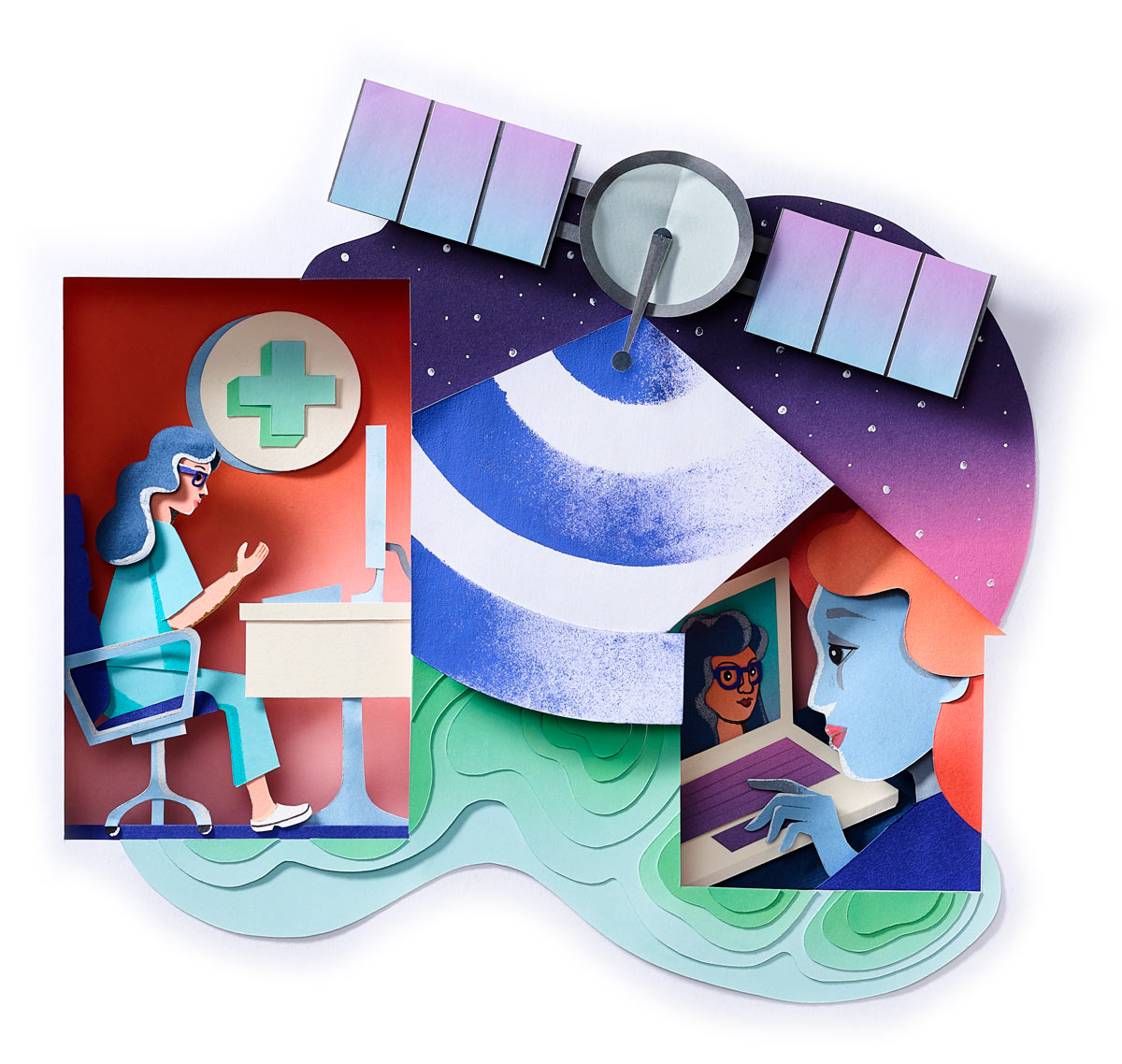

Coal Mine

paper art by HELEN MUSSELWHITE

Coal Mine

paper art by HELEN MUSSELWHITE


Coronavirus sticker shock like this has shined a new spotlight on an aspect of the medical system called balance billing — better-known as “surprise billing” — when treatment by a provider outside of a patient’s insurance coverage, unbeknownst to the patient, can unexpectedly jack up costs.
“This is particularly a problem during the current pandemic, because hospitals have brought in additional staff, so there’s always the possibility you end up with an out-of-network doctor,” says Jack Hoadley ’72, a research professor emeritus at Georgetown University. “The bills aren’t a surprise, but the size of them is.”
Hoadley has been battling the phenomenon for a decade, helping both state and federal lawmakers craft bills to squelch the practice. While patients may get paperwork on site alerting them to charges, problems may occur, he says, in emergency situations. During a crisis, patients aren’t in a condition to make decisions about fees or know when an out-of-network provider, such as an anesthesiologist or radiologist, is working in their in-network health care facility. “You don’t have the same degree of control in these types of circumstances,” he says.
Federal lawmakers passed rules in April requiring insurance providers to cover the full cost of COVID testing, but that coverage doesn’t extend to treatment. The high cost of caring for patients who may end up in an ICU for weeks, combined with the chaotic scramble to provide care in the first few months, has led to dramatic new examples of surprise bills. “We don’t want anyone to forego treatment for COVID, fearing a surprise bill, because of the public-health implications,” Hoadley says. “We don’t want it to happen for any illness.”
Surprise billing is just one health care practice that has emerged as an even more pressing issue during the pandemic. As the coronavirus has swept through hospitals in the last year, the intensity of the disease has put stresses on the American medical system as never before — and revealed already-existing flaws that have affected patients and providers alike.
“Our revenue models for hospitals are driven by reimbursements,” says Professor Amy Wolaver, economics, the former director of the Bucknell Institute for Public Policy. “Hospitals are losing revenues at the same time they are seeing increased expenses in dealing with COVID.” Those pressures are causing some to rethink how we deliver health care, not just during the current crisis, but beyond.
For starters, there’s the high cost of COVID care. “Patients get very, very sick,” Thompson says. “They don’t just stay on ventilators for three to four days — they are staying on them for two or three weeks.” Those patients require expensive drugs to immobilize the body so it can be intubated. At the same time, hospitals are spending money on protective equipment and capital costs to redesign facilities for social distancing and increased capacity. “They are changing operating rooms and recovery rooms into ICUs,” she says.

Even when hospitals can schedule procedures, they are having to implement new safety protocols that reduce their number. “Maybe you could do 20 patients a day before, but now you are doing 15 because you have to extensively clean between patients,” Thompson says. As of July, she says, hospital inpatient admissions were down 20%, and outpatient admissions were down 35%.
Finally, the coronavirus has caused a surge in patients who are uninsured or on federal assistance programs such as Medicaid and Medicare. “Our patient mix is changing, because people have lost their jobs and their health care coverage,” Thompson says. Since those programs only reimburse at around 90% of hospitals’ costs, the shift has contributed to more declines in revenue. For the first four months of the pandemic, the AHA estimated, hospitals in the United States lost a combined $50 billion a month. While that bleeding has since slowed, the organization estimates the total loss for hospitals this year will reach a stunning $323 billion — nearly 30% of net patient revenue.

The Susquehanna Valley, says Wolaver, has avoided the catastrophes that have battered other areas. “Our area has been pretty lightly touched,” she says. “We haven’t been crushed like some hotspots up to this point.” Even so, the effects have definitely been felt by Geisinger Health, the region’s primary health care system. “Like most hospitals, there’s been a very serious drop in income,” says John Bravman, president of Bucknell and chair of Geisinger’s board of directors. “Geisinger is losing many tens of millions of dollars a month due to COVID.”
While the 105-year-old hospital system runs as a nonprofit, it has struggled financially in past years due to the increasing needs of the surrounding rural population, Bravman says, including statistically higher rates of lung disease from smoking and obesity.
“We found that, like many places, we were not prepared for a situation of this magnitude,” he says. So far, Geisinger has not had to furlough doctors as some health care systems have done, though it has reduced salaries and increased hours to deal with the crisis. “We’ve dodged the bullet so far,” Bravman says, “but like everywhere else, everyone is concerned for their careers.”
In order to keep patients safe, Geisinger has allocated funds to place plexiglass screens in front of counters and refurbish waiting rooms — removing seating to ensure proper social distancing. In some instances, the hospital system has asked patients to wait in their cars for text messages telling them when to come inside for appointments.
In addition, Congress allocated $175 billion in emergency funding for health care providers, including $5 billion for rural hospitals. While those funds have helped, says Thompson, they’ve also been spread out widely among hospitals, doctors, dentists and other providers. Given the magnitude of hospitals’ losses this year, the AHA was advocating in July for another $100 billion in future aid packages.
Acceptance of government money came with a condition, however. Health care providers would have to promise not to issue any surprise bills for out-of-network providers for actual or “presumptive” COVID patients. That victory came on the heels of a long fight by advocates to ban surprise billing more broadly, which was coming close to a compromise by the end of last year, says Hoadley. Ironically, however, he worries that Congress will be less likely to pass a surprise billing measure in the midst of the COVID crisis. “The pandemic has really sucked up all of the energy in Congress,” Hoadley says.
While nearly everyone agrees that surprise billing must be stopped, the difficulty is figuring out how to do it. The main issues, Hoadley says, are determining who will be responsible for absorbing surprise costs — the insurer, the hospital or the doctor — and how the cost will be determined — through a fixed rate, a formula, an arbitration process or a combination of approaches. “We don’t try and sell them on some magic approach,” Hoadley says. “We give them a menu of options and help them do the picking.”
So far, 16 states have passed comprehensive legislation to protect against surprise billing, including Georgia (whose law Hoadley helped advise on its way to passage this spring). Another 14 have passed partial protections. That still leaves 20 states, mostly in the South, the Great Plains and the Great Lakes regions, without any protection at all. Hoadley is still hopeful that Congress will return to the issue to pass a comprehensive national bill this year — in the lame-duck session after the election if not before.
“If you asked me prepandemic, I would have said there was a 50/50 chance,” he says. “Now I would say we’re less than 1 in 4.” One potential boost to the effort is that one of the main advocates on the issue, Sen. Lamar Alexander (R-Tenn.), is retiring and looking to make passage a last legacy accomplishment. “Hopefully, as things quiet down later in the year, they’ll get back and finish what they started,” Hoadley says.
For Geisinger, the crisis has validated the hospital’s research team, which created its own COVID-19 test with a rapid turnaround rate in the early days of the pandemic, Bravman says. “It’s always a question of how much you can afford to spend on research when you are not a university research hospital, but we are proud of our research team,” he adds.
The crisis has also given new urgency to efforts by Geisinger and other hospitals to move toward more holistic health care management, including using technology to monitor patients at home. “That’s where telemedicine can really create an impact,” Bravman says. Being able to quickly and easily check in with patients to ensure they are adhering to diet, medicine and behavioral recommendations could help improve health and drive down costs for patients and hospitals alike. “Nothing will work unless we get patients engaged in their own health care,” says Bravman. “Home health care management is the key.”
Hospitals are starting to work with insurers to provide that kind of preventative care more broadly, says Thompson. Some low-income patients, for example, don’t have a reliable refrigerator at home in which to store vital medicine such as insulin. “They can’t get their insulin, so they are back in hospitals 20 times a year,” she says. Providers and insurers are implementing programs to provide refrigerators to those patients, keeping them out of the hospital and improving their health and quality of life overall.
The coronavirus crisis has also fueled efforts to make more radical changes to the system, for example, replacing the fee-for-service model with a fixed-fee system based on the total number of patients in the system. Such a system, which is currently active in Vermont and other areas, gives an incentive to insurers and providers to reduce costs through preventative care and drives down the number of overall procedures performed. Of course, the devil is in the details for those proposals as well. If a small rural system performed five heart surgeries in a year, the cost could bankrupt them.
“We have wide agreement that we don’t like a number of things about health care and health care policy,” says Wolaver. “The problem is we don’t agree on how we should fix it.” As the coronavirus pandemic hopefully begins to fade in the coming year, the conversation will no doubt turn once again to a broader examination of the health care system in the U.S. Expect bold changes on a federal or state level to expand health care coverage and reduce costs to be in play.
“Whether that means Medicare for All, expansion of the Affordable Care Act, a public option or further expansion of Medicaid, the lessons from the pandemic definitely strengthen the argument for doing something,” says Hoadley. “Whatever changes are eventually implemented, hopefully when the next crisis hits, the American health care system will be in a better position to weather the storm.”